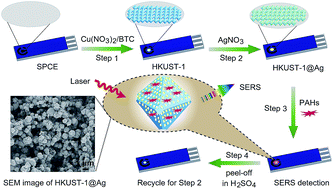This paper reports the fabrication of a highly sensitive and reusable substrate for surface-enhanced Raman scattering (SERS) analysis. Core–shell metal–organic framework (MOF; HKUST-1)@Ag nanoparticles (NPs) are prepared on a screen-printed carbon electrode (SPCE) via in situ electrodeposition. The morphology and Ag coverage of core–shell structures can be easily controlled by electrodeposition potential and time without substrate motion. The HKUST-1(Cu)@Ag composites combine abundant SERS “hot spots” among the high-density Ag NPs and the excellent adsorption performance of the MOF, resulting in effective pre-concentration of analytes in close proximity to these “hot spots” and enhancement of SERS sensitivity. The optimized polyhedral HKUST-1@Ag structures exhibit high SERS activity for detecting 4-aminothiophenol at a concentration as low as 5 × 10−10 M. More importantly, the polyhedral HKUST-1@Ag composites provide high sensitivity for detection of polycyclic aromatic hydrocarbons (PAHs) while preserving the cyclability and selectivity required for reliable quantitative analysis. The method is effective over a wide range of PAH concentrations (0.5 nM to 0.5 M), with detection limits as low as hundreds of pM. This study offers a new method to tailor the structure of MOF-based SERS substrates for on-site screening or point-of-care applications.

